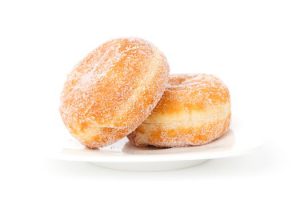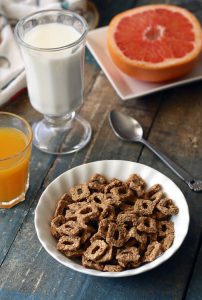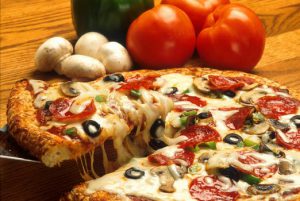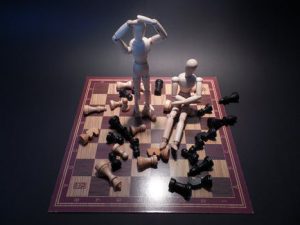When I started my food journey, losing weight wasn’t my primary goal. I wanted to be healthier. Sure, I’d wanted to lose weight for years, but not leading a healthy life seemed to have finally caught up with me. I was only 23 and already my life was becoming less vibrant due to the diagnosis of a health-induced disease I’d never even heard of: diverticulitis.
wanted to be healthier. Sure, I’d wanted to lose weight for years, but not leading a healthy life seemed to have finally caught up with me. I was only 23 and already my life was becoming less vibrant due to the diagnosis of a health-induced disease I’d never even heard of: diverticulitis.
I was determined not to be held back by this disease and ready to make the necessary changes to be healthier. I didn’t want more things to stand in the way of my life or honestly my love of food. Therefore, my first step had to be proper goal setting.
What causes Diverticulitis
 In 2013, I had a health scare at work, which resulted in my cousin, Monica, taking me to the hospital. About a month later and after much pain,my doctor diagnosed me with diverticulitis. He informed me that I would have to immediately adopt a diverticulitis diet.
In 2013, I had a health scare at work, which resulted in my cousin, Monica, taking me to the hospital. About a month later and after much pain,my doctor diagnosed me with diverticulitis. He informed me that I would have to immediately adopt a diverticulitis diet.
If you have older family members, you’ve likely heard of diverticulitis or diverticulosis. Diverticulosis is a common, irreversible chronic condition marked by the appearance of tiny pouches in the digestive tract. It can effect folks at any age, however, the most common time of onset is between the ages of 40 and 60. Diverticulitis is an infection in the colon caused by eating certain foods that get stuck in pockets (diverticula) in the colon.
Like Type 2 Diabetes, this disease is highly preventable.
Disease Prevention
All you have to do to avoid getting diverticulosis is eat enough
fiber everyday. However, most people don’t; and once you have it, there is no cure. So to prevent further damage, I stopped eating the foods that
were now hurting me (corn, nuts, and small seeded fruits and veggies like strawberries and okra). I simultaneously began trying to figure out how to incorporate more fiber into my diet (here meaning general way of eating, not a temporary change to lose weight). This was tricky, as all the foods I mentioned above are high in fiber. It did, however, make me take a good look at what I was eating and how I was eating it.
Not a Youngin’ Anymore
 In college, I could lose weight just eating pizza every day. Post graduation, I couldn’t.
In college, I could lose weight just eating pizza every day. Post graduation, I couldn’t.
What changed?
My portions, the amount I ate everyday, and the amount of fruits
and veggies I consumed regularly. So I realized it was going to take some time for me to find the foods I needed to eat and learn how to get healthier. What I could and did do immediately was what I do anytime I start something new:
I thought about my immediate and ultimate goals.
The small steps in between had to be figured out, but without a plan my goal was just a dream.
What is Goal Setting
As with anything, getting healthier often seems to also involve losing weight.  There was only one problem: I constantly failed at doing so. It wasn’t that I didn’t want to lose weight. I wanted to for years. It was like an endless cycle. I tried. I failed. I retried. I re-failed.I was embarrassed to even mention losing weight, due to the fear that I’d keep failing and then everyone would know it.
There was only one problem: I constantly failed at doing so. It wasn’t that I didn’t want to lose weight. I wanted to for years. It was like an endless cycle. I tried. I failed. I retried. I re-failed.I was embarrassed to even mention losing weight, due to the fear that I’d keep failing and then everyone would know it.
Then I realized I was approaching weight loss entirely wrong.
I knew how to set goals for success in things like school or business. Why should weight loss be any different?
It was then I realized my constant desire to figure out how to lose weight was masking my ability to do so smartly. To prevent further disease and lose weight in the process, I decided to apply my goal setting skills I successfully used for other goals in life to losing weight.
Smart Goals and How to Set Them
 If your just starting your own food journey, spend some time
If your just starting your own food journey, spend some time
(about a week) thinking about what you want to do for your health.
Do you want to lose weight, maintain weight, or gain it? Do you
want to have more energy? Do you want to take preventative measures against potential health issues, like I did? Whatever your goal is, break it down into at least two obtainable goals.
My immediate goal was to increase my daily fiber intake. My ultimate goal was to naturally increase my overall health.
What are your goals? Be sure to share them in the comments below, If you’re looking for extra help setting or obtaining your personal health goals, feel free to reach out to me directly here. I’d love to help you in anyway I can.
Bonus Tips
Don’t get overwhelmed with your health goals. There are several vehicles to  reach any goal. We will explore many healthy ones here at FoodiO, and are welcome to ask questions about anything I post. If you don’t see a method you’re considering using to reach your goals, reach out to me here, and I’ll be sure to cover it for you to the best of my ability.
reach any goal. We will explore many healthy ones here at FoodiO, and are welcome to ask questions about anything I post. If you don’t see a method you’re considering using to reach your goals, reach out to me here, and I’ll be sure to cover it for you to the best of my ability.
Please remember what worked for me may not work the same way for you. What’s important is you’re taking charge on your health. You will obtain your goals if you create small obtainable goals and implement the steps necessary to obtaining them. If you are having trouble coming up with a plan, spend a couple of days reflecting on your daily routine in a micromanagement way. This can help you to zero in on things that may need to be changed about your current lifestyle.